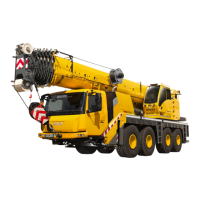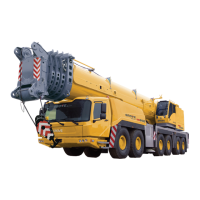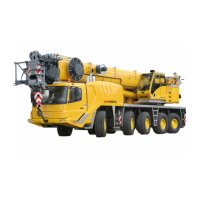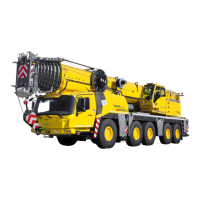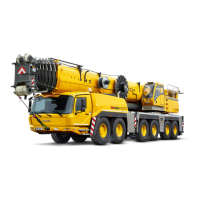Maintenance overview
5.4 Measures required for winch monitoring
25.11.2016
Maintenance manual 3 302 364 en 5 - 23
GMK 4100L-1
Determining the
operating
conditions
(load spectrum)
The truck crane's load spectrum is divided into groups (see also ISO 4301/1,
FEM 1.001):
H
When determining the load spectrum, the existing rope pull is used as the
standard, i.e. under certain circumstances, the truck crane can be
supporting a small load, whereby the winch is actually supporting a heavy
load, e.g. due to insufficient reeving. Therefore, the following graphic
representation of the load spectrum refers to the winch's rope pulls.
s
Load
spectrum
class
Definition Proportions of the running
time
Factor of
the load-
spectrum
Km =
Graphic representation
Light
Q1
L1
Power units or parts
thereo
f that are su
bject
to high stress in
exceptional situations,
but which are generally
subject to only low
stress
10% of the running time with
greatest load
(dead load + 1/1
payload)
40% of the running time with
dead load
+ 1/3 payload
50% of the timing period with
dead load
only
0.125
Medium
Q2
L2
Power units or parts
thereof that are su
bject
to high stress quite
frequently, but which
are generally subject to
only low stress
1/6 of the running time with
greatest load
(dead load + 1/1
payload)
1/6 of the running time with
dead
load
+
2/3 payload
1/6 of the running time with
dead load
+
1/3 payload
50% of the timing period with
dead load
only
0.25
Heavy
Q3
L3
Power units or parts
thereo
f that are su
bject
to high stress frequently
and medium stress
continuously
50% of the running time with
greatest load
(dead load + 1/
1 payload)
50% of the timing period with
dead
load
only
0.5
Very
heavy
Q4
L4
Powe
r units or parts
thereo
f
that are regularly
subjected to the highest
stress from adjacent
stress sources
90% of the running time with
greatest load (dead load + 1/1
payload)
10% of the timing period with
dead load
only
1
